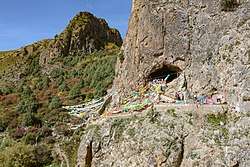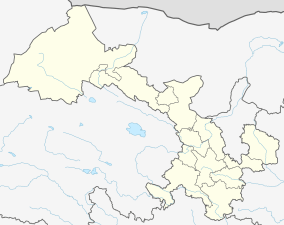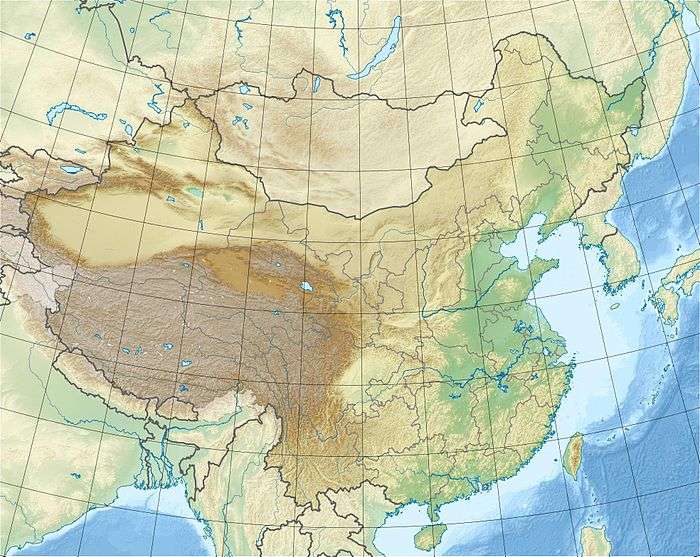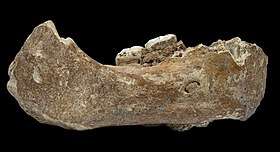Baishiya Karst Cave
Baishiya Karst Cave (Chinese: 白石崖溶洞) is a Tibetan Buddhist sanctuary and a high-altitude paleoanthropological site located on the northeastern edge of the Tibetan Plateau in Xiahe County, Gansu, China. This karst cave is the site of the discovery of the earliest hominin fossil found on the Tibetan Plateau, the Xiahe mandible. The mandible, by way of palaeoproteomic analysis, is the first confirmed discovery of a Denisovan fossil outside of Denisova Cave. This fossil discovery shows that archaic hominins were present in a high-altitude, low-oxygen environment by around 160,000 years ago.
白石崖溶洞 | |
 | |
 Location in Gansu  Baishiya Karst Cave (China) | |
| Location | Xiahe County, Gansu, China |
|---|---|
| Region | Ganjia Basin, Tibetan Plateau |
| Coordinates | 35°26′53″N 102°34′17″E |
| Altitude | 3,280 m (10,761 ft)[1] |
| Type | karst cave |
| Length | > 1 km (3,281 ft) |
| Width | 20 m (66 ft) |
| Height | 10 m (33 ft) |
| Site notes | |
| Excavation dates | 2018 |
| Archaeologists | Zhang Dongju, Chen Fahu |
Geography
Baishiya Karst Cave is located in Ganjia (甘加镇), Xiahe County, Gannan Tibetan Autonomous Prefecture, Gansu, China, on the northeastern edge of the Tibetan Plateau.[2] It lies on the southern side of Dalijiashan Mountain,[1] at the foot of a white cliff.[3] The cave is situated in the Ganjia Basin, at the mouth of the Jiangla River, a tributary of the Yangqu River.[1] The cave is over 1 km (3,281 ft) in length.[1] Within 80 metres (260 ft) from the entrance, the cave's winter daytime temperature is normally 8–9 °C (46–48 °F), suitable for habitation in the harsh winters of the Tibetan Plateau.[4]
Religion
Baishiya Karst Cave is a Tibetan Buddhist sanctuary[3] lying north of Baishiya Temple.[1] Said to be a former abode of Padmasambhava and the bodhisattva Tara, it is a popular location for monks to fast and meditate.[2] It is also a pilgrimage site for Tibetan Buddhists and a tourist attraction. In 1982, the 10th Panchen Lama paid homage to the site.[2] According to legend, the cave is more than 50 kilometres (31 mi) long and goes all the way to Xunhua County in Qinghai province.[2]
Fossils

In 1980, a Tibetan monk who was meditating in the cave discovered the Xiahe mandible. He passed the fossil to Jigme Tenpe Wangchug, the sixth Gungthang tulku, who donated it to Lanzhou University.[3][4][5] The mandible was so unusual that researchers did not know how to classify it.[4][5] Scientists Chen Fahu and Zhang Dongju began studying the site in 2010, while collaboration with the Max Planck Institute for Evolutionary Anthropology began in 2016.[6] The first archaeological survey at the site was performed in 2016, while the first systematic excavation did not take place until 2018.[3] Several lithic artefacts and animal bones with cut marks were discovered at the entrance to the cave.[1]
The Xiahe mandible consists of the right half of a partial mandible with two attached molars.[1] By way of protein analysis, researchers concluded that the Xiahe specimen belonged to a population that was closely related to the Denisovan specimens from Denisova Cave.[6] This is the first time that an ancient hominin was successfully identified using only protein analysis.[7] It is the most complete known Denisovan fossil.[7] Discover, Science News and Nova all named the discovery in their lists of Top Science Stories of 2019.[8][9][10]
References
Citations
- Chen et al. 2019.
- GNRTV 2016.
- Hublin 2019.
- Wu 2019.
- Gibbons 2019.
- Max-Planck-Gesellschaft 2019.
- Warren 2019.
- Scharping, Nathaniel (31 December 2019). "Denisovan Research Reveals That Early Humans Were More Complex Than We Thought". Discover Magazine. Retrieved 2020-02-25.
- "Top 10 stories of 2019: A black hole picture, measles outbreaks, climate protests and more". Science News. 2019-12-16. Retrieved 2020-02-25.
- "The top 10 science stories of 2019". www.pbs.org. Retrieved 2020-02-25.
Bibliography
- Chen, Fahu; Welker, Frido; Shen, Chuan-Chou; Bailey, Shara E.; Bergmann, Inga; Davis, Simon; Xia, Huan; Wang, Hui; Fischer, Roman; Freidline, Sarah E.; Yu, Tsai-Luen; Skinner, Matthew M.; Stelzer, Stefanie; Dong, Guangrong; Fu, Qiaomei; Dong, Guanghui; Wang, Jian; Zhang, Dongju; Hublin, Jean-Jacques (2019-05-01). "A late Middle Pleistocene Denisovan mandible from the Tibetan Plateau" (PDF). Nature. Springer Science and Business Media LLC. 569 (7756): 409–412. doi:10.1038/s41586-019-1139-x. ISSN 0028-0836. PMID 31043746.CS1 maint: ref=harv (link)
- Gibbons, Anne (2019-05-01). "First fossil jaw of Denisovans finally puts a face on elusive human relatives". Science; AAAS. Retrieved 2019-05-01.
- "那些不能错过的甘南美景之白石崖溶洞" (in Chinese). Gannan Radio and Television. 2016-12-20. Archived from the original on 2019-05-04. Retrieved 2019-05-02.
- Hublin, Jean-Jacques (2019-05-01). "How We Found an Elusive Hominin in China". SAPIENS. Retrieved 2019-05-02.
- "First hominins on the Tibetan Plateau were Denisovans". Max-Planck-Gesellschaft. 2019-04-11. Retrieved 2019-05-01.
- Warren, Matthew (2019-05-01). "Biggest Denisovan fossil yet spills ancient human's secrets". Nature. Retrieved 2019-05-01.
- Wu, Bin (2019-05-02). "这块骨头来自一个神秘人种,证明16万年前古人类已登上青藏高原". Sohu (in Chinese). Retrieved 2019-05-02.CS1 maint: ref=harv (link)